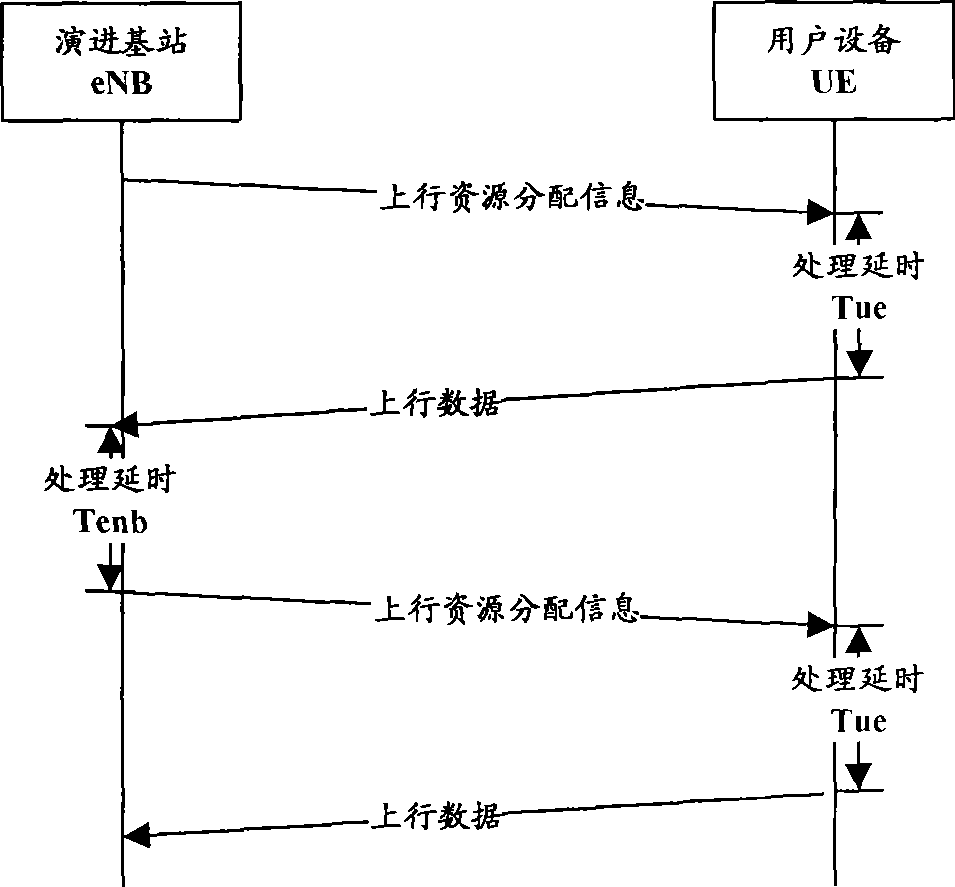Uplink scheduling method, system and device in TDD system
A resource scheduling and resource technology, applied in network traffic/resource management, communication between multiple stations, electrical components, etc., can solve problems such as reducing system transmission performance, and achieve the effect of dynamic scheduling
- Summary
- Abstract
- Description
- Claims
- Application Information
AI Technical Summary
Problems solved by technology
Method used
Image
Examples
Embodiment 1
[0040] In the first embodiment, it is assumed that the interval d corresponding to the UL Subframe P of adjacent Frames does not overlap in time, as shown in the formula [2]:
[0041] Ts+Tenb+Tue≥HARQ_RTT-Tframe [2]
[0042] Among them, Tframe is the length of a Frame.
[0043] Embodiment 1 corresponds to the case where the overlapping sub-interval is equal to 0. In this case, the system pre-configures the delivery time interval of the UL Grant as the maximum available interval d, and pre-configures the uplink sub-frame scheduling strategy, that is, the uplink sub-frame in the UL Grant The implicit correspondence between the frame index USI and the UL Subframe in the scheduled wireless frame Frame is: after the UL Grant for the UL Subframe P is processed by the UE, it always schedules the next nearest UL Subframe P, and at the same time, according to the existing LTE technology The corresponding relationship between the USI and the subframe number of the ULSubframe is also pr...
Embodiment 2
[0057] In the second embodiment, it is assumed that the interval d corresponding to the UL Subframe P of the adjacent Frame overlaps in time, as shown in the formula [3]:
[0058] Ts+Tenb+Tue
[0059]Embodiment 2 corresponds to the case where the overlapping sub-interval is greater than 0. In this case, since each wireless frame has two adjacent wireless frames, for a UL Subframe P in a specific wireless frame, its corresponding lower The maximum available interval d of the issued UL Grant is divided into three parts, including two overlapping sub-intervals at both ends and a non-overlapping sub-interval in the middle. The interval is the second coincident subinterval. Such as Figure 6 As shown, for the maximum available interval d corresponding to UL Subframe P in wireless frame Frame N+3, it is divided into three parts including: unavailable subinterval, located in the middle of d; and UL Subframe in Frame N+2 The first overlapping subinterval between...
Embodiment 3
[0073] Embodiment 3 also corresponds to the case where the overlapping sub-interval is greater than 0. For this case, the measure taken is that in each overlapping sub-interval, only the ULSubframe P of the Frame with a larger frame sequence number among the adjacent Frames sends the UL Grant. In this case, the system pre-configures the time interval for issuing the UL Grant as the remaining interval in the maximum available interval d except the second overlapping subinterval, that is, including the non-overlapping self-interval and the first overlapping subinterval. The system pre-configures the uplink subframe scheduling strategy, that is, the implicit correspondence between the uplink subframe index USI in the UL Grant and the UL Subframe in the scheduled wireless frame Frame is: After the UL Grant for UL Subframe P is processed by the UE, the UE Determine the sub-interval receiving the UL Grant, if it is received in a non-coincident sub-interval, then send the uplink data ...
PUM
 Login to View More
Login to View More Abstract
Description
Claims
Application Information
 Login to View More
Login to View More - R&D
- Intellectual Property
- Life Sciences
- Materials
- Tech Scout
- Unparalleled Data Quality
- Higher Quality Content
- 60% Fewer Hallucinations
Browse by: Latest US Patents, China's latest patents, Technical Efficacy Thesaurus, Application Domain, Technology Topic, Popular Technical Reports.
© 2025 PatSnap. All rights reserved.Legal|Privacy policy|Modern Slavery Act Transparency Statement|Sitemap|About US| Contact US: help@patsnap.com



